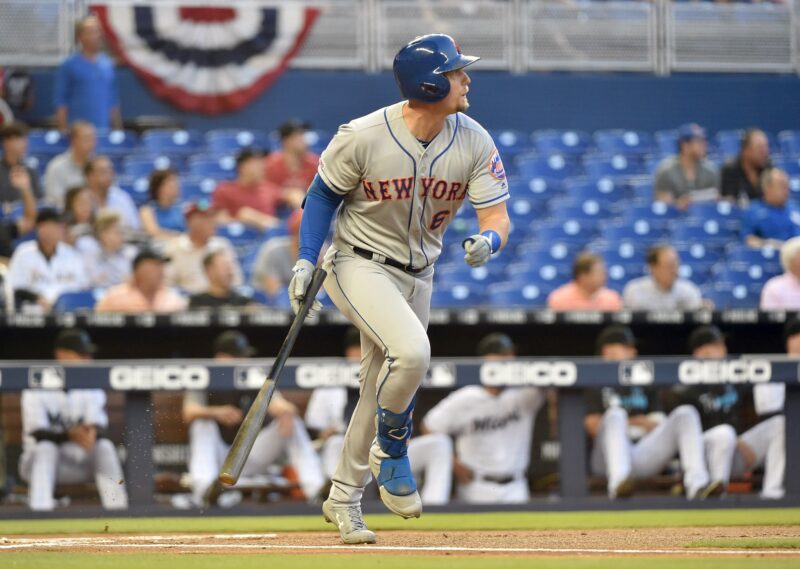
Death, taxes, and Jeff McNeil racking up base hits. Those are the only guarantees in life.
Following an impressive rookie season with the New York Mets, he’s been doing more of the same in 2019. With Wednesday’s series finale against the Philadelphia Phillies in the books, McNeil is boasting a .424 batting average, which puts himself among the league leaders. Of course, solely looking at batting average isn’t enough to conclude whether a player is performing well or not, but he’s still providing plenty of value in other parts of his offensive game.
His 6.1% walk rate is a small increase over what he did in 248 plate appearances last year, while his 9.1% strikeout rate is nearly identical to the mark he produced as a rookie. He hasn’t hit a home run yet but has racked up six extra-base hits, which has led to a .119 ISO, 178 wRC+, and 0.8 fWAR.
Oh, and he’s done this while lining up at three different positions (second base, third base, and left field). Dude seems to be pretty good. With numbers like the ones McNeil has produced in the early going, one can imagine he’s been doing plenty of things right at the plate, which is true. What changes can we see when comparing this hot start to last year’s performance, though?
Swinging Less Often
When we say “swinging less often” here, that doesn’t mean McNeil has suddenly turned into a passive hitter — the man still likes to swing the bat and make a lot of contact. It’s quickly become one of his hallmarks in the batter’s box, but it has gone down slightly.
Among batters with 240-plus plate appearances in 2018, McNeil’s 56.0% swing rate was among the 15 highest. He’s still among the league leaders so far this season by swinging at a 53.7% clip, but the 27-year-old has cut down on his chase rate while keeping his swing rate on strikes at an elite level.
| Year | O-Swing% | Z-Swing% | Swing% |
|---|---|---|---|
| 2018 | 35.3% | 84.2% | 56.0% |
| 2019 | 30.7% | 82.4% | 53.7% |
This has led to less contact being made in each situation, but the change is less drastic inside the strike zone (90.9% in ’18 to 88.1% so far in ’19) compared to outside the strike zone (74.9% in ’18 to 66.7% so far in ’19).
Which, coincidentally enough, goes hand in hand with the next topic…
Better Contact
McNeil has seen a decrease in fly balls at the moment, but that’s not necessarily a huge deal because he’s not around to hit dingers — he can leave to Pete Alonso. Here’s a look at how his batted-ball profile compares to 2018, along with some quality-of-contact numbers.
| Year | LD% | GB% | FB% | Soft% | Hard% |
|---|---|---|---|---|---|
| 2018 | 21.6% | 38.7% | 39.7% | 22.0% | 30.2% |
| 2019 | 26.4% | 50.9% | 22.6% | 6.1% | 38.8% |
McNeil’s .359 BABIP from last season already seemed pretty high, but after seeing some of the above numbers, it’s not at all shocking to see it rise up to .500 so far in 2019. He’s produced a 478 wRC+ with a .929 BABIP on line drives thanks to an increase in hard-hit rate (39.5% to 42.9%) and a much more drastic decrease in soft-hit rate (18.6% to 0.0%).
Crushing Sliders and Sinkers
There aren’t many pitches McNeil hasn’t had success against this year, but two in particular that stand out are — you guessed it — sliders and sinkers. And it’s not as if he didn’t perform well against them last year, either.
In 2018, the left-handed hitter produced a 156 wRC+ against sliders and a 151 wRC+ against sinkers, with more power coming against sliders (.258 ISO) than sinkers (.077). He’s seen each pitch at least 25 times in ’19, and the results have been eye-popping.
While his strikeout rate against sliders is up at 28.6% right now, he’s paired it with a 234 wRC+, 1.238 OPS, and .167 ISO. He hasn’t struck out yet when facing a sinker and has compiled a 353 wRC+, 1.700 OPS, and .300 ISO.
At this point, it’s rather clear that McNeil’s skills with the lumber makes the Mets’ lineup much more dynamic. As players like Todd Frazier and Jed Lowrie eventually come back to the active roster, this is one dude who shouldn’t see his playing time get altered in the slightest.















